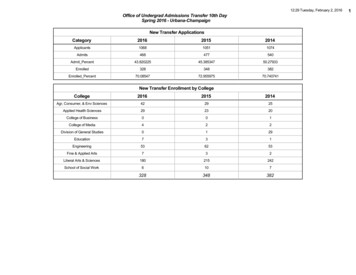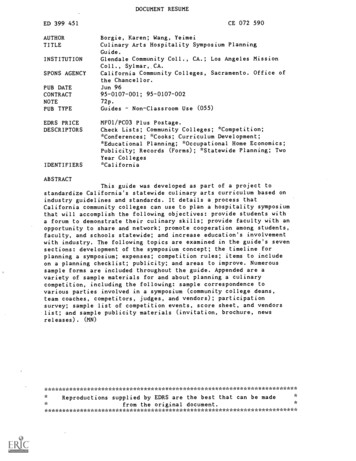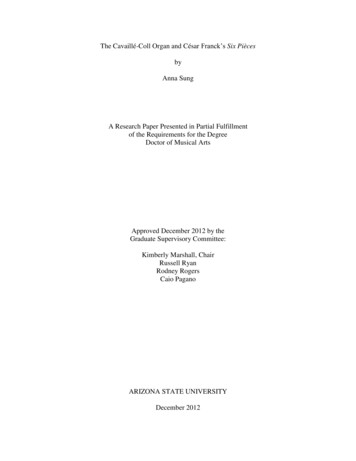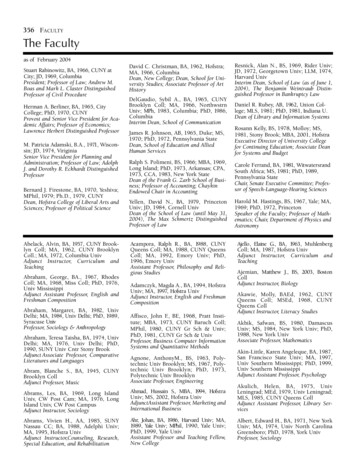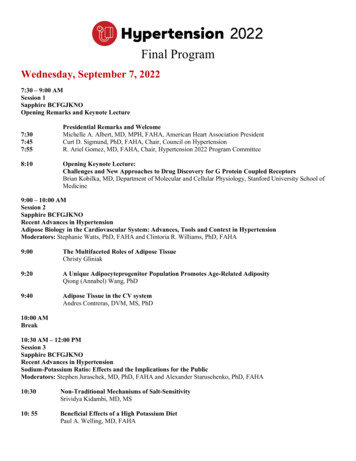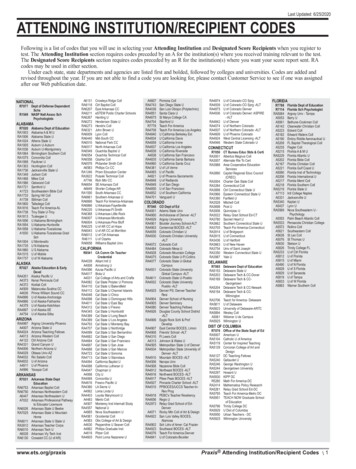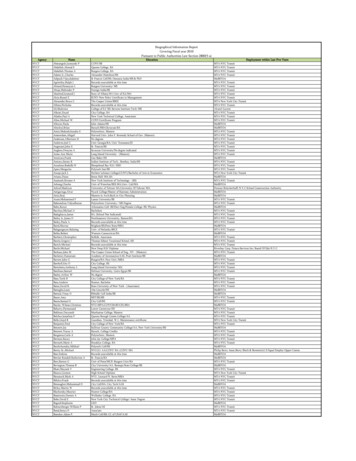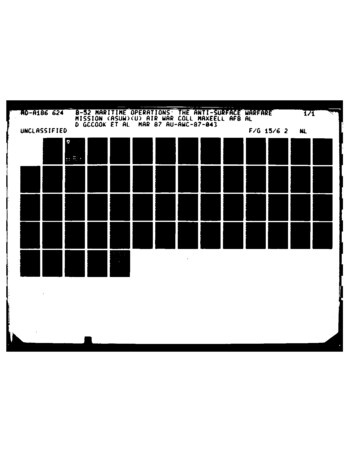
Transcription
- 86-52 MARITIME OPERATIONS-HE ANTI--UlFUWMISSION (ASUW)(U) AIR WAR COLL MAXEELL AFP AL0 GCCOOK ET ALMAR 87 AU-AWC-87-943UNCLASSIFIEDFRF/G 15/6 E.
04.
AIR WAR COLLEGMSRESEARCH REPORTNo. ME OPERATIONS: THE ANTI-UB-5SURFACE WARFARE MISSIOA4 (ASUW)By LIEUITENAV COLO"IEL T)ONALD G. COOK,. lJSAF;r9OMANDER CHARLES H. HORNE, USN; AND COMMAN!'ER WALTER W. MANNING, IISN0001.&NeAIR UNIVER TUNITED STAtR5AIR FORCEMAXWELL AIR FORCE BASE, ALABAMAFOR PtUBLICDIf 'DSRBTO""
AIR WAR COLLEGEAIR UNIVERSITYB-52 MARITIME OPERATIONS:THE ANTI-SURFACE WARFARE MISSION(ASUW)byDonald G. Cook,Charles H. Horne,i.ieutenant ColonelCommanderUSAFUSNandWalter W. ManningCommanderLSNA RESEARCH REPORT SUBMITTED TO THE FACULTYINFULFILLMENT OF THE RESEARCHREQUIREMENTTHESIS ADVISOR: Colonel William P. MooreNTISOTICCRA&ITA3.MAXWELL AIR FORCE BASE, ALABAMAM.\RL tlr y .1987Dist,.Ir1Ki.-
TABLE OF CONTENTSc\rLERPAGE1)!S(LAL[MER-ABSTAINER .iABSTRACT .BIOGRAPHICAL SKETCH .!it!1'.VVIViii1iiiiviNTRODUCTION .i,ANTISURFCE WARFARE .3SOVIET N.XVAL (OMBATANTS .6LNITED S ATES NAVY ANTI-SURFACE WARFARE FORCES.101-52 AND HARPOON MISSILE COMBINATION . 14THE B-52IN THE ASUW ROLE .20B-52 AND O\ER-THE-HORIZON TARGETING .28P-52 VLLNERABILITYiN STANDOFF AsUW .38CONCLUSIONS .-16LIST OF REFERENCES .49iiiI.
DISCLAIMER-ABSTAINERThis research report represents the views uf the authorsand does not necessarily reflect the official opinion of the,r%,Ar" College or the Departments of the Air Force or Na\y.This document is the property of the United Statesg;vernment andis notto be reproduced in whole or in partrithout permission of the commandant, Air War College,Maxtwell Air Force Base, Alabama.1k
AIR WAR COLLEGE RESEARCH REPORT ABSTRACT"I r ,.':B-52 MARITIME OPERATIONS:WARFARE MISSION (ASUW)ALDonald G. Cook, Lieutenant Colonel, LSAFCharles H. Horne, Commander, USNWalter W. Manning, Commander, USNORS:THE ANTI-St RFALEFor the past 20 years, significant growth in Sovietnavalforce structure has occurred. Without question, thisbuild uip has allowed Soviet presence and influence to spreadon a globalscale. Our efforts to counter this threat is ofmajor concern. As a partner with the Navy, the Air Force canprovide valuable assistance in successfully defending theSea Lin es of Communications. The B-52 represents a credibl.:,iong range i eapon system capable of conductingsurface warfarethe anti-(ASUW) mission.This paper discusses the Soviet surface threat, how thenavy presently counters the threat, and how the B-52 can beintergraded in to navalfleet operations.Iv
BIOGRAPI! ILAL ShETCH,it-utenantiv',.r.:.-,(olonelDonald G. Cook (MBA,Southernillinoisis a Command Pilot w ith over 3000 hours flyingtime. He has held various operational and staff positions inthe\ir Training Command,.Tcrr'.nu. Most recently,Hg AFMPC,and the Strategic AirLTCol Cook served as the Ccmmander,325 Bomnbardment Squadron,Fairchild AFB WA.He isa graduateof the Instrument Pilot Instructor School, Squadron OfficerSchool, Armed Forces Staff College and the Air War CollegeS19X7 )Commander Charles H. Home, is a pilot with 5000 hoursflying time. He has flown the EC-130 in Patuxent River,Maryland; P-3Cs in Jacksonville, Florida, and the P-3B inBarbers Point, Hawaii. He has held various operational andstaff positions in the Air Training Command, Pensacola,Florida and COMPATWING II, Barbers Point, Hawaii. Prior toattending Air War College, he served as Operations Officer,\P-17, Barbers Point, Hawaii.Commander Walter W. Manning (M.S., United States NavalPostgraduate School), has been interested in joint maritimemi.,onssince serving along with U.S. Air Force unitsdeployed to Keflavik, Iceland in 1975. After the fielding ofthe Harpoon missile on both the Navy's P-3 and the Air[arce's B-52 aircraft, he became interested in exploringVI
jii".\*it t:.'lUdi,!a72-7"),srv'icehasi -Sunt,.-he hold!,Southeastserved as a P-3(.\SL'Wfaretour' aboardandinF"thedestroyerupera Lio s .USS Krausthe Combat Action RibbornAsia.A pilotPatrolwithPacific, andIndian Oceans.He isStatesAcademy,ofclassclass of 1987.VL'9overlI(DD-849)for3000,I I dinthishours,hePlane Commander and MissionCommander during operations throughoutNavalii s' ithe Atlantic,a graduate1972 andtheoftheAir WarUnitedCollege,
INTRODUCTIONin thelate i960s the size of the United States Navy'sfleets began to decline significantly. In round figures theNavy's assets dropped from over 1,000 battle force ships inthe inid-1960s to fewer than 500 such ships in the latterpart of the1970s. The rational for this decline was predic-table and included the decomissioning of aging ships,Department of Defense(DOD) budget cuts, and a consciousdecision by the Navy.to down size its fleets to modernizefor the future.(1:175)Of key importance in the overallbalance of naval power was the decrease in the main element.of power projection in the nation's maritime strategy. TheUsited States Navy's aircraft carrier force had fallen to analarmingly low number:13 front-line carriers and no escortcarriers. Although the ships remaining in the fleet, andthose under construction, were steadily improving over theirpit-decessors, "there had been a substantial lossity relative to the Soviet Union."in capabil-The Soviet Navy hadadvanced in both numbers and sophistication, and had emergedoi&Lo the world's oceans as a major "blue-water" navalpower. (2:323)From1970 to 1977 the Soviet shipbuilding program hadprovided an increase of 25 percentII1in missile-equipped ship*
db60. pt-rcerat. i ticreatse inLLLS ('Arr:t r-s,nai drhucI --a Y submarines. (2:327hresta and 10-nda, classk ildin cl ass destroyers,C0opVft:Ces coulde t eMissiles,(h 'ieclasscruisers,and Nanunefhkla classthreaten free-'world navies with antishipsomefrom rangessubmarines,design edup to 300 miles.for submergedThelaunchingof a.tiship missiles, coiuld now attack with SSN-7 cruisefrom a range of 30 miles. This capabiliQy vastlyrissiies%2ompllcaited the ASW problem and crucially limited responset'ime to counter the incoming missile-s.Concurrently, theSoviets amassed a force of over 300 naval bomber aircraftdtrmed withlong-range antiship missiles, capable of attack-ing the carrier battle groups from beyond the engagementranges of its surface escort ships.C3:299)Combating this growing Soviet surface threat has been onthe DOD agenda for over a decade but not 3olely in thecontext of a naval counterthreat. The DOD turned its attention toward the United States Air Force for additionalassets, specifically the E-3A Airborne Warning And Control(AWAC) aircraft and the B-52, as potential counter-surfacet.hreat platforms. This challenge has been met head-on by the;avy and Air Force Service Chiefs through the exchange off-tfic-er,6jointexercises, and recent acknowledgment thatAizrospace Maritime Operations is a legitmate Air Forceon.
ANT[-SCRFACE WARFARE(ASUW)Anti-Surface Warfare(ASUW), or as it was formerly knownAnti-hurface Ship Warfare, is afundamental naval warfaretask. It is defined as, "the destruction or neutralizationof enemy surface combatants and merchant ships."Its primaryaim Is to deny the enemy the effective use of has surfacew.arships and cargo carrying capacity.(4:1-4-2) While ASt iforces serve primarily to deter or defeat an enemy's heavilvarmed sarface combatants and other lesser naval units, it isalso a means to prevent the unrestricted use of the seas byarny surface vessel. Further, ASUW can be either offensive ordefensive in its application, or threat of application. Itis offensively waged in a preemptive strike on enemy navalvessels ani during fleet-on-fleet engagements, yet defensive when applied for protection. For example, ASUW isconsidered defensive against the aggressive actions of anenemy force seeking to attack sea lines of communications(SLOCs), or threatening to strike an amphibious landingfC,-rce.The following historical sketch serves to illustrate theevolutionary character of naval warfare, and ASUW in particujar, during this century:Prior to World War II, enemy surface ships weresought out and engaged by other surface ships.Surface ships had numerous heavy guns that couldef'ectively neutralize enemy shipping as well asbase support, areas. With the advent of aircraft,ar'rier warfare in World War 1] , the role of thei3
surface ship changed to support fast carrierI to!operations. Heavy guns were no rier'saircraft and the submarine assumed therc--.puinsibilitLes for neutralizing enemy targets atgreat distances from the tas.k force. The sur-facecombatant took on the responsibilities of airdefense and close-in anti-submarine warfare operations for the carrier battie group.(5:49)The revolutionary effectsthat air power iwould make onthe future of anti-surface warfare were apparent early-on--?aific.;The Battle of the Coral Sea(May-4-8,194-12),inthefirst carrier battle of the war, also became the first navalengagement in history where the opposing ships never camei:ithin sight of each other, even though there were sixseparate naval task forces involved ini the battle. in addit-ion to carrier aircraft, land-based aircraft. were employedby both sides.The Japanese employed search, fighter, andbomber aircraft from Rabaul, New Britain, while the Americanforces w.ere supported by B-26s from Australia.(6:662/7)Though tactically exploited with some success, the perfurmance of the land-based aircraft also pointed to one ofthe basic difficulties of their employment:target identifi-cation and recognition. The Japanese pilots from Rabaul*.returned to their base reporting they had sunk a battleshipand a cruiser, when in fact they had attacked a detachedi(nited States oil tanker and her escort destroyer. Theemmistake made in identifying the targc.,, prompted theJiipanese to launch a full attachto the vicinity of thestricken oiler.a fruitless attempt to findThis resulted in-
there.aij.der ofashuint-d the.ydisastrousthecarriertaskhad stumiled upon.mistakeinidentityforcewhichtheJapaneseLater a potentially moreoccurred. Aflightof B-26sattacked an Australian cruiser-destroyer force whichtheymisto:Jk for Japanese warships.(6:665)Scarcely a month later,the scenario wasrepeated atthe [attle of Midway. Again, while the decisive engagementswere achieved by carrier-based fighters, bombers, andtorpedo planes, land-based aircraft were employed as search,scouts, and attack aircraft. However, the naval vessels fromthe opposing fleets never sighted or engaged one anotherduring the conflict.Like the Coral Sea, the battle was entirely acontest of airpower. The Japanese were never giventhe opportunity to employ their immensesuperiority in surface ships.(6:687)Though these battles clearly demonstrated that thefuture of naval warfare and sea-based power projection wouldbe shaped by the offensive force of aircraft carrier battlegroups, they also left little doubt that the sphere of antisurface ship warfare had moved beyond the line-of-sight ofnaval vessels. Naval combat had truly entered the over-thehorizon targeting era.I
SOVIET NAVAL SURFACE COMBATANTShe use of Lnited States Navy carrier aircraft providedtle ability to conduct naval warfare from over-the-horizonand to project power ashore with airstrikes. These capabilities had not escaped the concern of the Soviet politicalandnilitary leadership as early as the late 1940s. Conse-quently,in the post-war development of Soviet military'j,.etrine and forces, the Soviet Navy was directed to developan ocean-going navy to challenge the preeminence of UnitedStates and Allied naval forces. Under Joseph Stalin, theRussian ship building industry was rebuilt, assisted in partby German technology and scientists. Work began on mediumrange submarines and surface ships in classes fromdestroyers to battleships; plans were even undertaken toc'onstruct aircraft carriers.After Stalin's death in 1953, Nikita Kruschev,pursuinga massive building program of intercontinental ballisticmissiles, prompted a basic reappraisal of the kind of shipsrequired to carry out the Soviet naval mission and appointedAdmiral Sergei Groshkov as Commander-In-Chief of the Soviet"avy:4Westernin place of Stalin's planned ocean-going fleet,Admiral Groshkov was directed to develop amissile-armed navy of small craft and submarineswhich could"defend theUnionthatfrom possiblewas hopedIt Sovietaggression.",omparatively inexpensive guided (cruise) missilecruisers could counter the US Naval Forces. theSoviet Nilitary planners were particularlyroecerned with US aircraft carriers which couldW60
launch planes carrying nuclear bombs aimed againsttheir homeland while several hundred miles at sea,and with amphibious forces which could land troopson Soviet coasts.(7:4)During the decade following Gorshkov's appointment,the!oviet Navy developed both surface ships and submarines thatcould launch antiship missiles at Allied and surface forces.Te Soviet Navy led the world in the employment of cruisemissiJes in naval warfare with the incorporation of the I00nautical mile range, SS-l "Scrubber" missile on the Kiidinand Krupny class destroyers and modified-Whiskey class submarines. They incorporated the 25 nautical mile range,SSN-2 "Styx" missiles on the OSA and Komar, high speedpatrol boats which were all fielded in the late 1950s.(7:22)Later, during the early 1960s, the Soviet Navy added morefirsts with the launching of the Kynda class guided missilecruisers, the diesel powered Juilet and the Echo II classnuclear powered guided missile submarines. Each platform wasarmed with the SSN-3 "Shaddock" antiship cruise missiles; atotal of 16 missiles on the Kynda (8 with 8 reloads), 6 and8 on the Juliet and Echo II class submarines, respectively.Receiving over-the-horizon targeting information from"either aircraft, submarines, or surface ships, this missilecould deliver up to one ton of high explosives or a nuclearwarhead against hostile ships or land bases from over 200nauttical miles away."(8:8)These forces were but the harbinger of future strides in
- ,, i e thinnaval1960's,siztf'oret, developmentLhe Soviet Navy'sand capability.three Kievbuildinsurface forcesprograis.Si ,i-have growl, bothSoviet naval construction has encom-passed new classes of allrines,andmajor combatants,(CVHG) classincluding subma-vertical/short takeoff andlanding (VSTOL) aircraft carriers, two Moskva (CHG) classhelicopter cruisers, and finally their first attack aircraftcarrier:@ The highlight of the year (1985) in SovietNavy construction was the launching of a new classof large (65,000-70,000 ton ) conventional takeoffand landing aircraft carrier. It is by far thebiggest ship ever built for the Soviet Navy and isexceeded in size world wide only by the US Navy'ssuper carriers. The new carrier will be nuclearpowered, 300 meters (985 feet) long,and will probably have an airwing of about 60 fixed-wing jetaircraft and helicopters.(9:98)The major surface ships of the Soviet Navy today haveevolvedwith even greater anti-surface weapon capabilitiesshowing marked improvements in firepower, range, speed andguidance systems. They are among the most heavily armed andcapable warships in the world. The true measure of theSoviet Navy's maturity and its capability to conduct anti-ship strikes is emphasized both by the number and types ofantiship missiles in their inventory, their great diversityin launch ranges, and the wide-range of naval units thatdeploy with these missiles. Though excluding the air-launched antiship missiles, the following table serves toilluistrate the magnitude of the antiship missile threat from8
theSoviet Navy'ssurface ships and submarineTABLEforces:( 1)ANTISHIP MISSILESApproximateM1ISSILLNATO PLATFORMS(CLASS)KILDIN, KRUPNYOSA I/I,25NANUCHk1\MAThASSN-2CSTYX (improved)SSN-3BSEPAL250KRESTASHADDOCK350ECHO 11,sSN-3t50SSN-7SSN-9SIRENOSA II,MOD KASHINMODiLDj ,MATE.TARANTUL I/1iNANUCHKA III, KYNDAJULIET30CHARLIE60NANUCHKA NavalKIROV, OSCAR60SOVREME.NYTARANTUL IIbased upon Appendix B,Developments, "KARA,KIROVKRESTA Il, LDALOY300---DataKIEV, SLAVAELHO 1[30--N- 2*OTE:300PAPAIiOfficeof"To UnderstandingtheOperations, Fifth Edition, April 1985.9ChiefofSovietNaval
LN1TED STATEb NAY ANTI-SURFACE WAR FARE FOItES:\s Soviet. navaliic)iizon,w;arfare strategybegan tofI,\:ovr-the-the United States Navy developed the concept of"Destruction-in-Depth" (both offensive and defensive}tocounter these weapons. The concept involves striking So\ietntvalforces beyond the launch range oftheir standoffteapons and providing sequential "layers" of kill opportunitiesfor "leakage," (aircraft and missilespenetratingthatsucceed inthe outermost engagements). The concept oflayered defense was developed in the late 1950s, to handlethe threatspresented by air-to-surface missileslaunched bythe Soviet's long-range bomber force and the SSN-3 aitishipcruise missile(ASCM}.(10:64)Today, destruction-in-depth is based on the ability ofcombined forces (both United States and Allied) to detectthe enemy well before he can reach his standoff weaponsrelease range, prevent closure to within launch range of themain elements of the naval task force, and maneuver additional elements of the task force to attack the threat. Thesame principles apply to all three fundamental naval warfaretasks:anti-air warfare (AAW), anti-submarine warfare (ASW),arid anti-surface warfare (ASUW). Execution of the conceptmayinvolve the full breath of naval forces, from mining of4,iiemy ports and geographic choke points, to discouraging orriieverting,.ahis massing of forces, or denying him access to,.ontrol areas:10
,.nti-surface warfare involves carriers, submar.tnes, cruise missile-equipped ships,and land,ased forces eliminating forward-deployed surfaceThis requiresships at the outset of the conflict.appropriate rules of engagement at. the brink ofsalvow,,z to avoid losing the battle of the firstwhich is so important in Soviet doctrine. Ouralliesalso have arole to playcriticalinanti-surface warfare. Germany, for example, will bearthe brunt of the campaign in the Baltic, while theTurks will be key players in the Black Sea. As ourforces move forward, antisurface warfare willcontinue, with a goal, the elimination of theSoviet fleets world wide.(ll:12)As previously pointed out, destruction-in-depth reliesf Lrst upon detection-in-depth. Early detection of theenemy's surface forces is essential to distant engagement bythe naval task force. Early detection from intelligencesources (including national and allied intelligence assets)and surveillance systems (United States Navy, sister services and allies) would be fed to the naval task forcecommander to provide him an over-the-horizon "picture" andassessment of the threat.(12:24)The Navy Tactical Data System (NTDS) aboard the surfacecombatants and aircraft of the force can correlate thediverse data. Additionally, they have the capability toexchange tactical information among the units of the forceand provide the task force commander with the type of "targeti;,g-picture" he requires for employing forces to counterthe enemy threat.To "ight-in-depLh"nents utilizingthe task force would make engage-its layered offensive and defensive11I.force.
r- touId be providied by a conb na i I ofI ,al,.i iNer,L il ;',,ri.-,I14bLi airit s0,u1batlants,Ssitie(S S.,.),missileig uf C'uis,-equipp,-.lL.,iomahawk or Harpoon equipped sur faceand i!a:'poon equipped land-based and carrie r-oastf, aircraft. Attack submarines patrolling severahundredmiles ahead of the task force could attack independently orin coordinatedstrikes with other units using Tomahawk orHiarpoon antiship cruise missiles,In addition to submarines, a vanguard naval surfaceforce could be tasked, based on intelligence reports, tocounter the enemy's anti-carrier warfare (ACW) surfaceships. This Surface Action Group (SAG) would consist of amixture of cruise missile equipped battle ships, cruisers,and destroyers. Long-range, land-based aircraft such as theP-3 and the B-52 are prime candidates to be used as Harpoonequipped platforms in the outer layer of defense.(13:l01)The next layer of engagement would likely be provided bya combination of carrier aircraft, P-3s, ships and submariies detached from the carrier battle group (CVBG). Early'arning, surveillance, and targeting for these forces wouldbe provided by the E-2C Hawkeye, while F-14 Tomcats providefighter cover. Rounding out this layer's air arsenal wouldhe the EA-6B Prowier. Designed to degrade enemy defenses byjamming their radar and communications, the Prowler wouldinroase both the effectivenessvabi i it. ofof the attack and the survi-!-he at tackers. (11:11)12
Sh,.-nldany enemy forcessurvive to close to theirJt'f %eapons range for launch of their missiles,they wouldbe SiIb.je(:.ed to a second attack as mentioned above.attaci%. wouldl a':,,take place beyond thestand-Therange of the Kiev's,or Kiro%'s cruise missiles. Hoiever to insureaccuracy beyond their radar horizon (about 25 miles) theserii.ori.iles require midcourse guidance from a targeting plat-.Thm.sisusually provided by either the flormone-bhelicopter carried by these ships or the Bear-D land-basedbomber.(7:33)(8:38) Thus, a preeminant part of this andearlier attacks iould be air-to-air strikes on the targetingaircraft by F-14s and F/A-18s, and surface AAW surface-toairmissiles. (11:14)Finally the defensive layers of the battle group wouldbe brought to bear on any leakage of cruise missiles orair-craft. The first layer to engage would be the F-14s andF/A-Ss followed by the surface-to-air missile platforms,and finally the point defenses, Sea Sparrows and Phalanxgatling guns.( 11:14)(5:60)13
B-72 AND tI. i bS ILF COMBIAILAT.Aiti-Surface Warfare: capabilityof lii. b-5,-volv-d from the United States Navy's de-of the HARPUON(AUM-84,kcruise missiiein tletAdmiral Elmo Zumwalt, ther. Chief of Naval Operations,had the missile's development expanded beyond its initiallyenvisioned use against surfaced Soviet cruise missile submar1Un-. This expansion of applicationsincludeditsuse as ananti-surface warfare weapon that could provide stand-offcapability by ships, aircraft, or submarines.(14:36) Precedence for air-launched, antiship guided missiles on navalaircraft had been established earlier with the Bullpup antiship variant. However, because of its limited range andmanual guidance, the Bullpup had become virtually ineffective as a standoff weapon against the Soviet's modern AAWdefenses.Meeting the challenge of the expanding Soviet capabilityto launch cruise missiles against United States and alliednaval forces and to interdict our vital sea lines of communication (SLOCs) hadbecomeincreasingly difficult. At atime when United States naval strength was declining, aspreviously outlined, the Soviets had achieved significantadvances in all threat categories: air, surface, and subsurface. Similar declines in the naval forces of our NATOallies exacerbated the problem, and led our defense plannersto investigate additional means to counter these threats:Ii0
In 1975, Secretary of Defense, James R.Schlesinger, proposed to marry the Air Force B-52with the Navy Harpoon antiship missile for use inthe sea interdiction role.(15:30)This proposal was given aboth"fair and cooperative" hearing bthe Air Force and the Navy;various options for provid-ing a standoff antiship weapon for the Air Force were evaluatted. Also, on 2 September1975 a Memorandum of Agreemen twas signed by Chief of Naval Operations, Admiral J.L.Holloway III,Jonesand Air Force Chief of Staff, General David C.to provide for "training Air Force resources in col-lateral maritime functions."(16:1)An evaluation of three options was undertaken. The threepotentialantiship weapons evaluated for the B-52 were theHarpoon, the GBU-15 glide bomb, and a laser-guided glidebomb(M-84). In 1976, the Air Force decided in favor of theGBU-15, an electro-optical guided weapon, which was an improved follow-on to the "smart bombs" used in Vietnam. Whilenormally employed on the MK-84, 2000 pound bomb, the GBU-15-iff redthe advantage of being a modular unit that wascompatible with various warheads. The GBU-15 could be lockedonto a target prior to launch or flown into the targetmanually by the B-52 navigator.(17:34) This flexibility,which permitted the use of the GBU-15 against land and navaltargets, probably accounted for its selection by the Air. Itsshort standoff range (approximately 7 miles) madeits ef'fectiveness and the survivability of the launching15"'
.-C raf'tusppueet,:.)"rd the newe'r,taff,Generalservicesincontrasttothe range of S.1 defens esSoviet warships.Lew AllenreportedThen Air.'Frceto the SenateClhief ofArmedCommittee:.that the Air Force had demonstrated the B-52scapability to killships with the GBU-15 guidedbomb; however, he stated that this weapon's standoff range "is really not quite good enough to getin:lose enough to teii-defended combat 6hips ofthe Soyiet Navy," although the GBU-15 could beeffective against some veaseis.(18:25)In 1982,the idea of arming the B-52 with Harpoon mis-'-ijes was again brought before the combined attention ofthe Air Force and the Navy. According to Richard Barnard, ofDefense Week:in his defense guidance -- the "definitiveframework" for strategic and tactical planning bythe military services which was prepared lastM rch -- Defense Secretary Casper Weinberger ord ,-red the Air Force to equip its B-52 bombers"with suitable radar and stand off conventionalweapons" to attack Soviet warships and navalports.(19:1)The Chief of Naval Operations, Admiral Watkins, and the Air!.crce Chief of Staff, General Gabriel, addressed the newguidance by issuing another joint memorandum of agreement(MOA).in their 9 September-h'./L.SAFEffortsoperation",1982 MOA, entitled "Jointro Lnhance USAF Contribution to Maritiffi-the two service chiefs stated:As refle-tedby the Defense Guidance, requisite marttime strength to keep all SLOC's open is.an indi.pensable component of the US militaryifs*.uve. Thhbiroadning threatt.o thiscapabilit3!I6
isflearly recognized and sustained efforts areunderway to regain maritime superiority. The conbined assets of the Navy and Marine Corps areinsufficient to meet the threat in all areas. Toobtain the best deterrent value and fighting capa.ility in wartime, a continued effort is needed toprepare for the optimal interaction of serviceforces. The Navy and the Air Force should therefore accelerate their joint efforts to exploittheir capabilities to enhance maritime operationsin defense of the SLOC's.(20:1)-t was further stated that while anti-air and counter-airoperations- were the two Air Force capabilities that wouldprovide the most immediate gains,.the Air Force willalso improve its antiship capability in support of the AntiSurface Ship Warfare (ASUW) mission."(20:1)*Following the signing of the 1982, Watkins-Gabriel MOA,the Harpoor missile replaced the GBU-15 in the antishippingweapon test program, and the B-52G models became the candidate aircraft, replacing the older B-52Ds which had begun tobe retired (the last B-52Ds were retired by October 1983).Moan%;hile other B-52G and H model aircraft were being adapted for employment as a weapons platform for the AGM-86 airlaunched, cruise missile (ALCM).(17:25) The B-52Gs notassigned as ALCM carriers became available for multi-missionconventional roles:USAF Strategic Air Command has earmarked 67 B52Gs for use in a conventional reconnaissance/strike role for the 1980s, as the B-IB becomesoperational. The fleet represents the balance ofthe B-52G force less the 99 aircraft beingmodified to carry cruise missiles, and they willb the first SAC aircraft to be expressly assignedto a non-nuclear mission. Currently the B-52 canstrike precision targets from a low-level overhead170!lfMlli,I'ML
run. With the proliferationof modern SAN systemssuuh an attac:k is likely to be too costly to becontemp LatLed. Under the conventional Stand-OffCapabi lity(CSC) program, the 67 conventionalstrike B-52Gs are to be given the ability toattack precision targets from outside SAM range.(21 :104)Consideringsystems,the complexity of typical airborne-eaponsthe integration of the Harpoon with the B-52Gsproceeded quite rapidly. By early 1983, the program hadcompleted allmajor milestones:The Air Force in cooperation with the Navycompleted a series of flight tests in March 1983,to demonstrate the capability to launch Harpoonsfrom B-52s. The test culminated with three livefirings against a Navy surface target. All threefirings were successful. A pair of AWAC planesequipped with maritime surveillance radars andtemporarily modified with Navy targeting systemsprovided surveillance and coordination during thetests, which were conducted on the Navy's PacificMissile Test Range and coordinated by theCommander of the Third Fleet.(22:38)Thus, the tests had not only proven that the B-52 and Harpoon combination could be successfully employed in antisurface warfare roles, but that the E-3A AWACs could serveas an over-the-horizon surveillance and targeting platformfor maritime forces. Moreover, it substantiated its worthfor coordinating naval surface engagements thereby enhancingthe total United States forces capability to conduct mariLime operations.Following these tests, the first operational B-52Gs were, (uifiedto carry and launch the Harpoon. The 69 BombardmentSquadron(69BMS)stationed at Loring AFB,18Maine became the pa
-86 -52 maritime operations- he anti-- ulfuw fr 01 mission (asuw)(u) air war coll maxeell afp al 0 gccook et al mar 87 au-awc-87-943 unclassified f/g 15/6 2 nt
